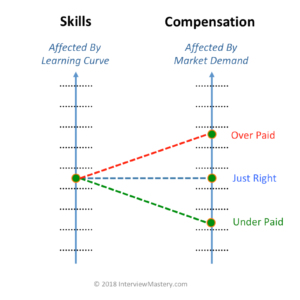 Our guest blogger today is Michael Neece, CEO of InterviewMastery.com. Michael spent 11 years building and leading top-revenue producing recruiting teams as both a team lead and top biller. He then was an internal corporate recruiter, director and VP at several Fortune 50 corporations and hyper-growth VC funded start-ups.
Our guest blogger today is Michael Neece, CEO of InterviewMastery.com. Michael spent 11 years building and leading top-revenue producing recruiting teams as both a team lead and top biller. He then was an internal corporate recruiter, director and VP at several Fortune 50 corporations and hyper-growth VC funded start-ups.
As CEO of InterviewMastery.com he used data analytics and research to find the secret best practices of interviewing and hiring. His products help recruiters make more placements ($5K to $10K per month) and save time (5-10 hours per month), by automating candidate prep so your candidates get hired faster. A self-described process optimization geek, Michael also designed a hiring process called “Selecting Excellence” used by high-growth firms to build teams 47% faster. Michael holds degrees in Physics and Engineering, and is an instrument-rated private pilot.
Interview Mastery is an Industry Partner of NPAworldwide.
Closing with Integrity in 2018
Your candidate is getting an offer from your best employer. You’ve done a great job conducting this recruiting effort, but you could still lose if your candidate does not accept the offer.
Old closing methods of intellectually weighing pros and cons have limited effectiveness. This decision is emotional and stressful for candidates, financially significant for you, and important to the employer-client who expects you to get a “yes.”
Here are three (3) “Tools of Influence” so you close with integrity and make more placements in 2018. Each technique has a diagram you can draw for your candidates so you communicate clearly. Each technique/diagram leads to the next one. You can use each diagram individually or paired with another, depending on your candidate’s career situation and mind-set.
1. Leaning Curves: “Is This the Right Time to Make a Change?”
Learning curves is a way to evaluate when it’s a good time to change positions. People often see job change as risky, but not making a change may be much riskier to a career.
During the first 3 years in a new job the learning curve is steep. You are learning new things at a high rate. Everything is new. You are working with new colleagues, acquiring new skills, learning about a new industry, and adding to your marketable skillset.
After three (3) years in the same job, the rate you are learning new things begins to slow down. Your career learning curve starts to flatten out and slow down. This is when your career security is at increasing risk. You’re relearning the same things. When this happens, it may be the time to change jobs.
Changing jobs after three years puts you on a new learning curve (as illustrated in the diagram) where you add new skills and experiences at a high rate. Getting on a new learning curve can add to marketability and career security by increasing the value you deliver to employers.
2. Skills versus Dollars: “Is This the Best Offer?”
The “skills versus dollars” diagram makes the connection between learning curves and compensation. Stated simply, the greater your in-demand skills, the greater your compensation.
The scale on the left shows the level of your in-demand skills (see diagram). The scale on the right shows salary range for a specific job and your compensation within the range.
There are three (3) possible situations when comparing skills versus dollars.
- First, your compensation might be too low for your skills. This is actually a good thing that’s easy to fix. Simply change jobs to an employer who pays people what they’re worth.
- Second, you may be paid too high for your skills. This is a high-risk situation because the demand for your skills is lower than you are paid. Some employers over-pay employees as a retention strategy that makes it harder to leave for another company. These golden handcuffs limit career choice, growth and mobility.
- Third, you are paid “just right” with the market demand for your skills. This is where you have the most career control to increase skills and pay.
The best and quickest way to increase compensation is to focus on learning in-demand skills. This will increase employer demand for you that drives up your compensation.
This supply-demand relationship demonstrates in the market forces that affect career security and success. To maximize career security, growth and compensation, focus your energies on accelerating your learning curves of in-demand skills
3. Block of Experience: “How Does This Job Affect My Career?”
This technique helps you illustrate the specific skills a candidate gains by accepting the job offer. The first diagram illustrates the different categories of experience the candidate currently has from two jobs. The categories of experience will be different for different job types.
- For a software engineer, categories of experience might include different software languages, development tools, operating systems, mobile, and industries.
- For a sales person, experience categories might include types of services or products sold, industries selling to and territory. Categories can also include complexity of sales process, characteristics of prospects and selling software tools.

- For a senior executive, case manager, project manager, or a nurse, the categories of experience will be totally different, and specific to each position type.
To get an idea of the appropriate experience categories look at the position requirements on the job description or the candidate’s resume.
The final diagram illustrates how blocks of experience expand by accepting the new job, hence making the candidate more marketable, more secure, making the right amount of money.
Watch video of these techniques explained at https://michael-r-neece.mykajabi.com/p/im4rec_4Tools.
For more tools to increase your recruiting revenues go to https://www.InterviewMastery.com.
